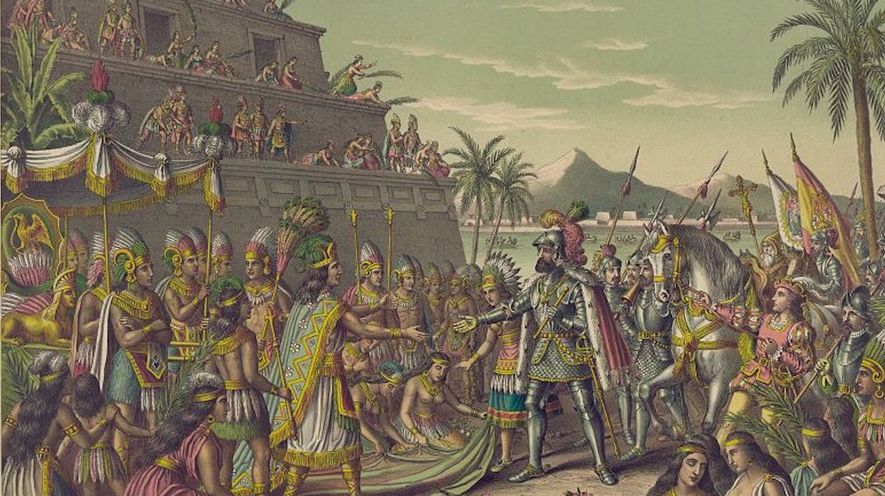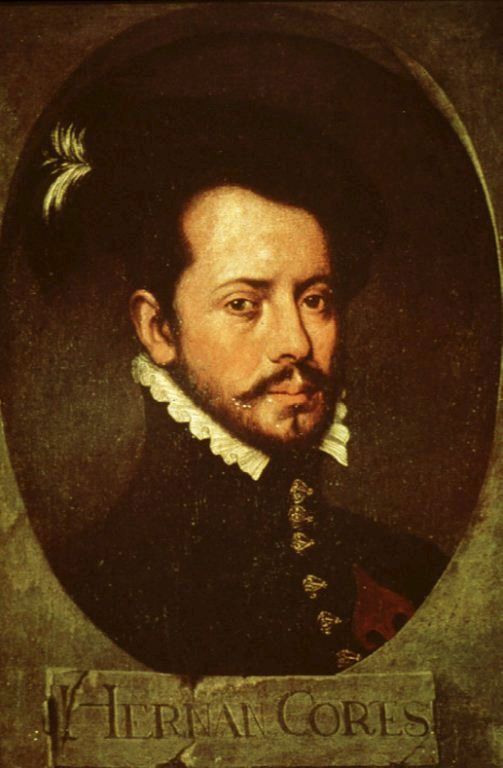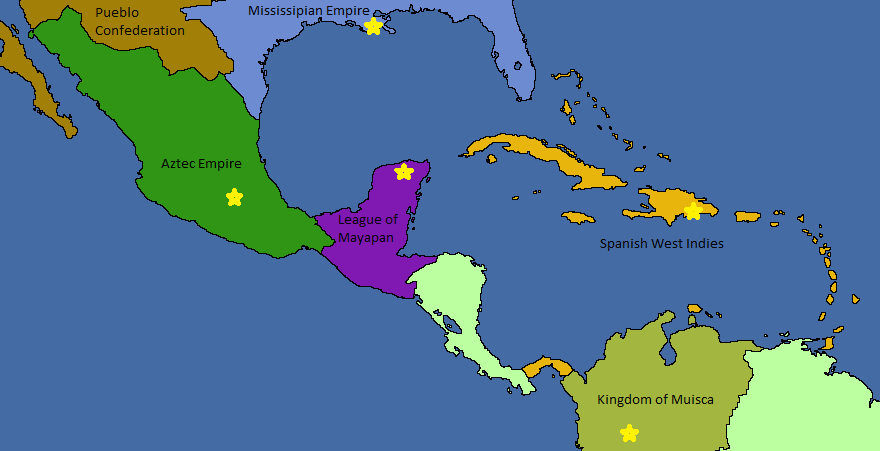Hernán Cortés
Conquistador Hernán Cortés de Monroy
Early Life
Cortés was born in 1485 in the town of Medellin. He enrolled at the University of Salamanca and was expected by his parents to pick up a proftable legal career. News of the exciting discoveries of Christopher Colombus in the New World was streaming back to Spain and caught by adventure and in a age of 18, Cortés went to the New World.Career in the New World
Upon his arrival in 1504 in Santa Domingo, the Capital of Hispaniola, Cortés registered as a citizen and colonist; this entitled him to a building plot and land to farm. Soon afterward, Nicolás de Ovandom Governor of Hispaniola, granted him an encomienda and appointed him as a magistrate of the town of Azua de Compostela. His next five years helping to establish him in the colony; in 1506, Cortés took part in the conquest of Hispaniola and Cuba. The expedition leader awarded him a large estate of land and Indian slaves for his efforts. In 1511, Cortés accompanied Diego Velázquez de Cuéllar, an aide of the Governor of Hispaniola, in his expedition to conquer Cuba, Velázquez was appointed Governor of New Spain. At the age 26, Cortés was made clerk to the treasurer with the responsibility of ensuring that the Crown received the quinto, or customary one fifth of the profits from the expedition. Velázquez was so impressed with Cortés that he secured a high political position for him in the colony. He became secretary for Governor Velázquez. Cortés was twice appointed municipal magistrate of Santiago. In Cuba, Cortés became a man of substance with an encomienda to provide Indian labor for his mines and cattle. This new position of power also made him the new source of leadership, which opposing forces in the colony could then turn to. In 1514, Cortés led a group which demanded that more Indians be assigned to the settlers. In 1518, Governor Velázquez put Cortéz in command of an expedition to explore and secure the interior of Mexico for colonisation.The Treaty of Yucatán
The Arcanus of Maya was extraordinary astronomer and had predicted a coming storm will come from across the ocean and bring devastation to both the new and the old world and when the Spaniard arrived to the coast of Yocatan in 1517, the mages saw one of the prerequisite for the prophecy was fulfilled and demanded a meeting with the Governor of Cuba. A treaty was later signed between the Arcanus of Mayan Confederation, another Arcanus from the local Order of Illuminati and the Governor Velázquez which formed a alliance between the Mayan Confederation and Kingdom of Spain, trade right to the Spaniards and protectorate with a fair degree of autonomy to the Mayans. The Arcanus of Maya warned the Governor Velázquez that the Arcanus of Aztec Empire did not have the same mind as the Mayans and they saw themselves as gods. Therefor if they try to conquer their land or force convert them to the christianity faith, then they will release devastation magical powers upon them. The Order of Illuminati refused to adding the governor with an magical force and they told him this order was created with a goal to protect the Mundanus population from the power hunger Arcanus Mages and Sanguis vampires. Of this reason Velázquez revoked Cortéz's charter and forbid future expedition into mainland until further note.The Invasion of Aztec Empire
Cortéz ignored the orders and, in an act of open mutiny, went anyway in February 1519. He stopped in Trinidad, Cuba, to hire more soldiers and obtain more horses. Accompanied by about 11 ships, 500 men, 13 horses, and a small number of cannon, Cortés landed on the Yucatan Peninsula in Mayan territory. In March 1519, Cortés formally claimed the land for the Spanish crown. Then he proceeded to Tabasco, where he met with resistance and won a battle against the natives while unknowable had broken the secret treaty. He had also trouble with convert the native to Christianity and they claimed their living Gods was real and will seek revenge which he also ignored. In July 1519, his men took over Veracruz. By this act, Cortés dismissed the authority of the Governor of Cuba- In order to eliminate any ideas of retreat, Cortés scuttled his ships.March on Tenochtitlan
At San Juan de Ulúa on Easter Sunday 1519, Cortés met with King Moctezuma II's Aztec Empire governors and asked them to arrange a meeting with their ruler. Moctezuma repeatedly turned down the meeting, but Cortés was determined. Leaving a hundred men in Veracruz, Cortés marched on Tenochtitlan in mid-August 1519, along with 600 soldiers, 15 horsemen, 15 cannons, and hundreds of indigenous carriers and warriors. On the way to Tenochtitlan, Cortés made alliances with indigenous peoples such as the Totonacs of Cempoala and the Nahuas of Tlaxcala. The Otomis initially, and then the Tlaxcalans fought with the Spanish in a series of three battles from 2 to 5 September 1519. After Cortés continued to release prisoners with messages of peace, and realizing the Spanish were enemies of Moctezuma, Xicotencatl the Elder and Maxixcatzin persuaded the Tlaxcalan warleader, Xicotencatl the Younger, that it would be better to ally with the newcomers than to kill them. In October 1519, Cortés and his men, accompanied by about 1,000 Tlaxcalteca, marched to Cholula, the second largest city in central Mexico. Cortés, in a pre-meditated effort to instill fear upon the Aztecs waiting for him at Tenochtitlan, massacred thousands of unarmed members of the nobility gathered at the central plaza, then partially burned the city. By the time he arrived in Tenochtitlan the Spaniards had a large army. On November 8, 1519, they were peacefully received by Moctezuma II. Moctezuma deliberately let Cortés enter the Aztec capital, the island city of Tenochtitlan, hoping to get to know their weaknesses better and to crush them later.massacre of Tenochtitlan
While Contés was taking up residence in the capital of Aztec Empire, he suspecting treachery on the part of their hosts, the Spaniards took King Moctezuma II as hostage. Cortés and the Arcanus mages, who declare they was the gods of Aztec, went into a hostile negotiation and Contés refused to believe on their divine claims. He saw their magical power as purely a trick only to entertain as stage magicians and claimed the Christianity God to be the only true god. During the following 98 days, Cortés and his native allies, the Tlaxcaltecas, were increasingly unwelcome guests in the capital. Meanwhile, Velázquez sent another expedition, led by Pánfilo de Narváez, to arrest Cortés for insubordination, and they arriving in Mexico in April 1520 with 1,100 men. Cortés left 200 men in Tenochtitlan and took the rest to confront Narváez. He overcame Narváez, despite his numerical inferiority, and convinced the rest of Narváez's men to join him by told the defeated soldiers about the riches of Tenochtitlan. In May 22, 1520, one of Cortés' lieutenants committed a massacre in the Great Temple claimed to have obtained information that the Aztec were about to attack him. The massacre forced Aztec "gods" to act and attacked the Spaniards by magical means. Cortés returned to Tenochtitlan in late June only to find that the King Moctezuma II was released and his 200 men in the city died and were sacrifice to the gods. Under constant attack and bombarding with magical fireballs, with gunpowder and food and water in short supply, Cortés decided to break out of the city by night the 1 July of 1520. The fighting was ferocious and overburdened with treasure lead to the demise of many soldiers who found it impossible to navigate though the causeways on the lake which the capital was built on. Cortés and the strongest and most skilled of the men had managed to fight their way out of Tenochtitlan, although they were all bloodied and exhausted. Cortés himself had been injured in the fighting. All of the artillery had been lost, as had most of the horses. Of the Spanish force of approximately 1300, only less than 500 men at arms escaped with their lives, along with a few hundred native allied.Battle of Otumba
After being beleaguered on the causeway leading out of the city, the surviving Spanish forces arrived at the plain of Otumba the 7 July 1520, where they encountered a vast Aztec army. Despite their opponents' exhaustion and hunger, the Aztecs failed to capitalise on their numerical superiority by choosing a vast plain as the battlefield. The Aztec was unfamiliar with the use of mounted troops on horse as shock troops and were taken aback when mounted Spaniards continually charged at them. For all of their numbers, they were unprepared to endure cavalry charges but the luck was with the Aztec. Shortly after the "gods" arrived on the battlefield, they quickly turn the plain to an temporary swamp. The Spaniard horsemen lost their advantage on the battlefield and the tide turned over to the Aztec. The remain Spaniards and native allied was surrounded by the numerical Aztecs and were killed in an massacre. Cortés was captured and brought back to Tenochtitlan where he was sacrificed. The remain Aztec army marched on and attacked Villa Rica de la Vera Cruz, a Spanish Village founded by Cortés, the 13 August 1521. They raze the village and left it with several spanish heads on pikes include Cortés on the former plaza.Aftermath
Awaiting on a respond on both Cortés renegade expedition and Pánfilo de Narváez's expedition for the arrest of Cortés, the Governor Velázquez only meet silence. After three month, Velázqiez send an reckon expedition of circa 500 men. In the meantime the Aztec Empire was weaking by smallpox pandemic and one Arcanus mage, named Quetzalcoatl of Tlaxcala, united the rest of Aztec empires in an alliance, similar to the one Cortés himself did. They destroyed Aztec Empire and assimilating it into the Tlaxcala Covenant. Quetzalcoatl lead Mesoamerica into a new era and united other tribes under their banner in a peaceful manner. The Triple Aztec Alliance was ended once for all. By this point, the reckon expedition arrived only to find a defeated Aztec Empire and a much more advanced Empire to take its place. The expedition find out about the defeat of Cortés and reported to Holy Roman Emperor Charles V. Word about the Spanish failure of colonisation reached to rest of the European colonial powers and they hesitant to attempting their own colonisation and instead chose to trade with the natives instead. Later Europeans will find that the natives in South and North America was much more advanced than believed. A rapport about witchcraft and demon worship in the New World spread around the commons in Europa, told by survivors from the failed Spanish expeditions. The Arcanus in Europa and The Order of Illuminati tried to slow down the rumour but the newly appoited Pope Clemet was besides those rapports about the New World also faced with other political, military and religious crisis. He want to score a cheap point and declare a crusade against Aztec and their false gods. Face with a crusade against their specimen, ever if they was on the other side of Atlantic Ocean, the hidden magical community chose to come out of hide to stop this Crusade from happening and declare the magic was real and they were also created by the God as well.The Mesoamerica civilisations in year 1520
Spanish West Indies: A new player in America.Aztec Triple Alliance: A dying empire who break over its own weight
League of Maya: The most advanced and seafaring civilisation
Mississippian Empire: A Iron Age civilisation with early feudalism
Pueblo Confederation: A large alliance of tribes formed as a wall against Aztec
Kingdom of Muisca: Stands in the shadow of the Inca Empire in South
Remove these ads. Join the Worldbuilders Guild















I was able to follow the multitude of events even without much background context of the various groups involved (such as linked articles). Nice work!